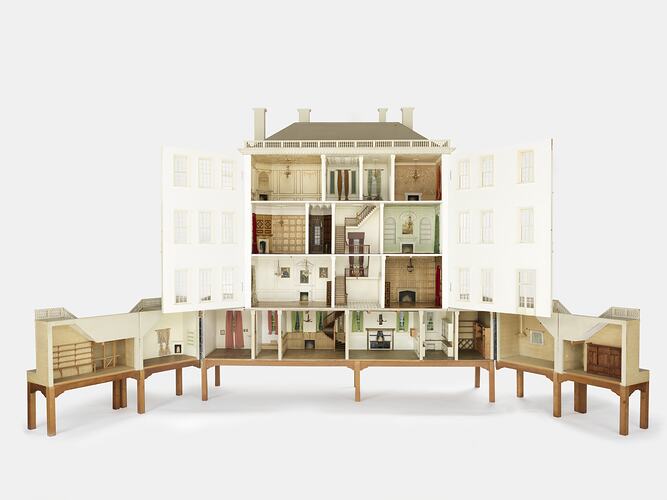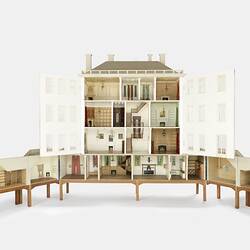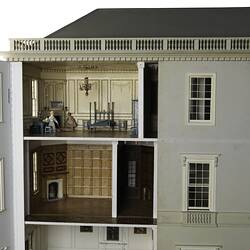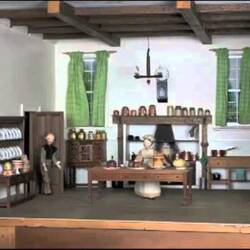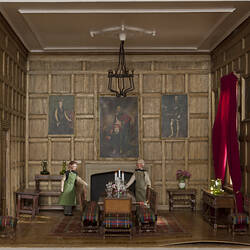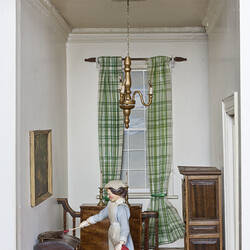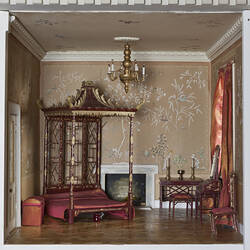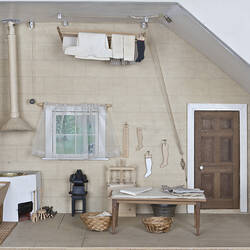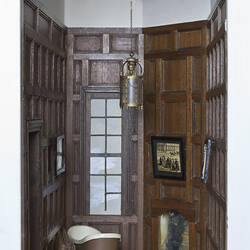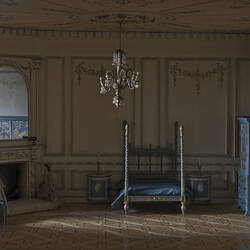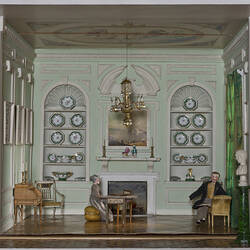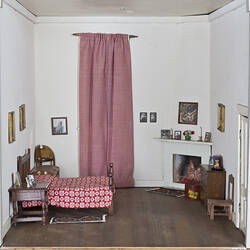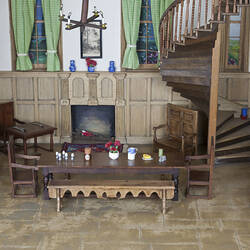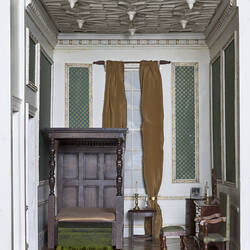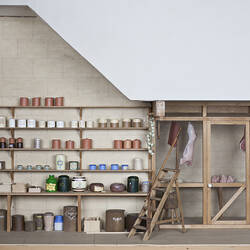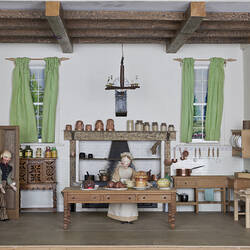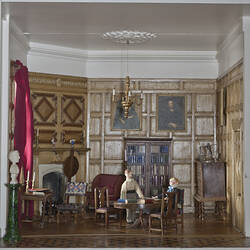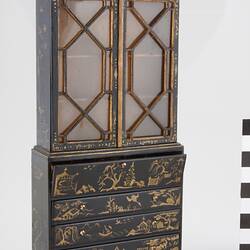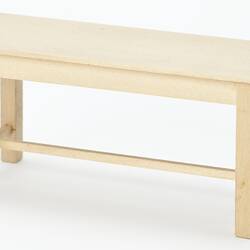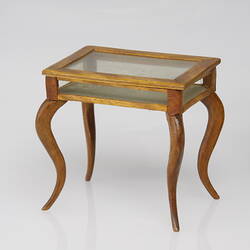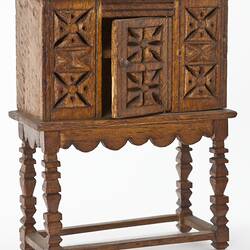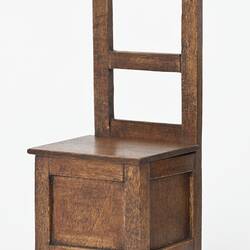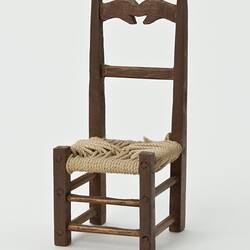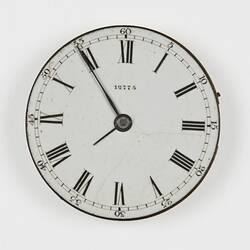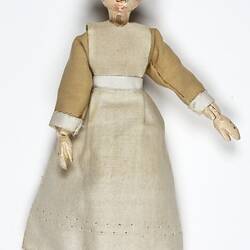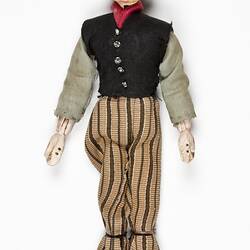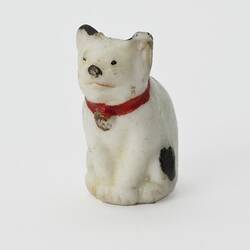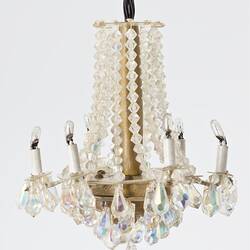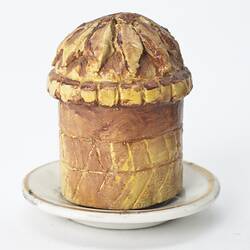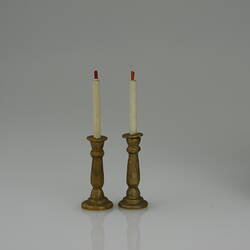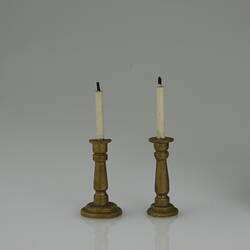Pendle Hall is a 21 room, four storey dolls' house built by Felicity Clemons, daughter of Sir Geoffrey Syme, Managing Editor of Melbourne's The Age and Leader newspapers from 1908 till his death in 1942. Born and educated in Melbourne, she moved to Tasmania after marrying Dr George Maxwell Clemons in 1934, aged 20. Felicity had already demonstrated her artistic tendencies through participation in a number of exhibitions held by the Arts and Crafts Society of Victoria (the forerunner to Craft Victoria.)
She commenced working on Pendle Hall in the early 1940s, after her daughter Antonia had been sent a small dolls' house by her grandmother. Felicity felt the house could do with some improvements, a whim which turned into a 40 year on-again, off-again project to turn it into a grand fully-furnished Georgian style country house, presented in a mid 19th century style with some remodelling representing new fashions in interior design.
Although some items were purchased during shopping trips to Melbourne, the majority of furnishings were constructed by Felicity's own hands, using numerous reference books and magazines, such as 'Country Life' (the doll's house itself actually appeared in the magazine in 1980). She carved, veneered and glued the furniture, often using her husband's scalpels to achieve a high level of detailing, as well as sewing, weaving, constructing and painting all the other bits and pieces found in the house; she also decorated the walls, ceilings staircases and floors of the house itself. In addition to the grander family rooms, her attention to detail can be seen in the 'below stairs' areas of the house, such as the kitchen, laundry and staff quarters.
By 1971, Felicity opened her own private Museum at Westbury, 30km west of Launceston, to display her large collection of furniture, toys, vehicles and other memorabilia. The building, now known as the White House, had been built in 1841 as a corner, store, bakery and resident. Clemons had restored the building, which she'd purchased derelict in 1969. Westbury is described as a very 'English' village, with hedgerows, lanes, and Australia's only traditional village green. Pendle Hall was displayed there from1971, and proved its most popular exhibit. It is known amongst dolls ouse enthusiasts around the world.
As well as being a wonderful item in its own right, the house is significant as an extraordinary example of one woman's artistic ability and ingenuity in creating such a masterpiece from scratch. Although constructed in Tasmania, Felicity had strong links to Victoria and one of its prominent families, and mastered many of the crafts demonstrated in the house during her time growing up in Melbourne. It is because of these ties that the family decided that the house would reside in Victoria.
The house is also significant as a tangible example of how many Anglo-Saxon Australians, particularly before the 1970s, proudly looked back to their British heritage and expressed this pride through architecture, interior design, literature, theatre, music and arts and crafts. Felicity Clemons displayed her pride in her ancestry through her 40 year dedication to the creation of Pendle Hall, ironically at a time when such houses in Britain were being dismantled and demolished due to the high cost of upkeep and the inability to find and finance the staff needed to run them. Australian collectors, such as William Johnston (whose house in East Melbourne now operates as a private museum), were able to buy and import items from these house dispersals, and create their own local shrines to their Britishness. Clemons had her own shrine in miniature - the magnificent Pendle Hall, which has the potential to engage, enchant and enthral children of all ages at Museum Victoria in years to come.
More Information
-
Keywords
-
Authors
-
Article types
